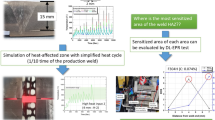Abstract
In the present research work, under different operating conditions, the corrosion behavior of the Indian RAFMS (IN RAFMS: 9Cr-1.4 W) and its surrogate material, modified 9Cr-1Mo steel (P91) in molten Pb–Li has been investigated using a number of specially developed test facilities offering isothermal and non-isothermal (under static and flowing) conditions. The diffusion of Fe across the Pb–Li boundary layer has been established to be the rate-controlling step in the case of IN RAFMS. Increase in temperature of exposure, flow velocity, and presence of a temperature gradient increases the attack of Pb–Li. Corrosion of ferritic/martensitic steels in Pb–Li is generally initiated by the dissolution of air-formed oxide layer which consisted of oxides of Fe and Cr. This accounts for an initial period of initial retarded corrosion rate which is termed as “Incubation period’ during which grain boundary penetration of Pb–Li was the dominating mode of corrosion. The mode of Pb–Li attack is changed with the dissolution of the oxide layer resulting in higher rates of corrosion.





Similar content being viewed by others
References
Chakraborty P, Kain V, Tewari R, Dey GK (2017) Corrosion of an India produced RAFM steel in flowing lead-lithium eutectic. Fus Eng Design 123:269–276
Chakraborty P, Kain V, Pradhan PK, Fotedar RK, Krishnamurthy N (2015a) Corrosion of modified 9Cr–1Mo steel in Pb–17Li in a rotating disc experiment at 773 K. J Fus Energy 34(2):371–378
Chakraborty P, Kain V, Pradhan PK, Fotedar RK, Krishnamurthy N, Dey GK (2015b) Corrosion of Indian RAFMS in Pb-17Li in a rotating disc corrosion test facility at 773 K. Fus Eng Des 100:181–189
Chakraborty P, Kain V, Pradhan PK, Fotedar RK, Krishnamurthy N (2015c) Corrosion of modified 9Cr-1Mo steel and Indian RAFMS in static Pb-17Li at 773 K. J Fus Energy 34(2):293–297
Chakraborty P, Singh V, Bysakh S, Tewari R, Kain V (2019) Short-term corrosion behavior of Indian RAFM steel in liquid Pb-Li: Corrosion mechanism and effect of alloying elements. J Nucl Mater 520:208–217
Chopra OK, Smith DL, Tortorelli PF, DeVan JH, Sze DK (1985) Liquid-metal corrosion. Fus Technol 8(2P1): 1956–1969.
de les Valls EM, Sedano LA, Batet L, Ricapito I, Aiello A, Gastaldi O, Gabriel F (2008) Lead–lithium eutectic material database for nuclear fusion technology. J Nucl Materials 376: 353–357
Harms AA, Kingdon DR, Schoef KF (2000) Principles of fusion energy: an introduction to fusion energy for students of science and engineering. World Scientific Publishing Company, Singapore
Laha K, Saroja S, Moitra A, Sandhya R, Mathew MD, Jayakumar T, Rajendra Kumar E (2013) Development of India-specific RAFM steel through optimization of tungsten and tantalum contents for better combination of impact, tensile, low cycle fatigue and creep properties. J Nucl Materials 439:41–50
Manly WD (1956) Fundamentals of liquid metal corrosion. Corrosion 12(7):46–52
Mistry AN, Sasmal CS, Sam S, Singh N, Prajapati A, Chauhan JP, Tailor HM, Albert SK, Laha K, Saibaba S, Bhaduri AK, Rajendra Kumar E (2017) Status of India-specific reduced activation ferritic-martensitic steel and fabrication technologies development for LLCB TBM. Fus Eng Des 125:263–268
Raj B, Rao KB, Bhaduri AK (2010) Progress in the development of reduced activation ferritic-martensitic steels and fabrication technologies in India. Fusion Eng Design 86(4–5):1460–1468
Zrodnikov V, Efanov AD, Orlov YI, Martynov PN, Troyanov VM, Rusanov AE (2004) Heavy liquid metal coolant–lead–bismuth and lead—technology. At Energ 97(2):534–537
Author information
Authors and Affiliations
Corresponding author
Additional information
Publisher's Note
Springer Nature remains neutral with regard to jurisdictional claims in published maps and institutional affiliations.
Rights and permissions
About this article
Cite this article
Chakraborty, P., Kain, V. & Tewari, R. Liquid Metal Corrosion Studies for Fusion Reactor Applications: Facility Development and Basic Research. Trans Indian Natl. Acad. Eng. 5, 11–16 (2020). https://doi.org/10.1007/s41403-020-00084-z
Received:
Accepted:
Published:
Issue Date:
DOI: https://doi.org/10.1007/s41403-020-00084-z




